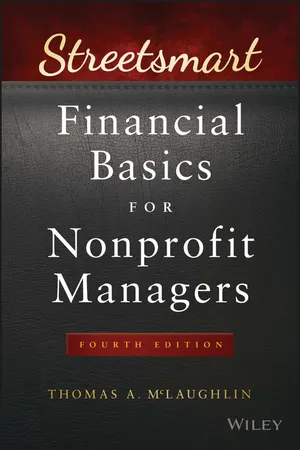
- English
- ePUB (mobile friendly)
- Available on iOS & Android
Streetsmart Financial Basics for Nonprofit Managers
About this book
The complete guide to the basics of nonprofit financial management
Let's be honest. Most books about financial management are densely written, heavy on jargon, and light on practicality. Expert financial consultant and author Tom McLaughlin takes a different approach with his fourth edition of Streetsmart Financial Basics for Nonprofit Managers. This comprehensive guide provides effective, easy-to-use tips, tools, resources, and analyses.
The light, humorous tone in Streetsmart Financial Basics for Nonprofit Managers makes it an accessible resource for nonprofit executives, board members, students, and those new to the field. This book forgoes useless, pretentious verbiage in order to outline real-world strategies that work. This edition includes:
- New insights, updates, vignettes, case studies, and examples to deal with the implications of nonprofit financial management
- An examination of nonprofit business models in relation to growing demands from the government and other funders
- How to construct business plans for virtually any nonprofit entity
- Customizable resources—including financial worksheets, forms, and Excel templates to help nonprofit managers complete their day to day assignments
- A guided tour through common aspects of nonprofit management, such as financial analysis, accounting, and operations
Practical and informative, Streetsmart Financial Basics for Nonprofit Managers is the go-to financial management reference for nonprofit managers, boards of directors, and funders.
Frequently asked questions
- Essential is ideal for learners and professionals who enjoy exploring a wide range of subjects. Access the Essential Library with 800,000+ trusted titles and best-sellers across business, personal growth, and the humanities. Includes unlimited reading time and Standard Read Aloud voice.
- Complete: Perfect for advanced learners and researchers needing full, unrestricted access. Unlock 1.4M+ books across hundreds of subjects, including academic and specialized titles. The Complete Plan also includes advanced features like Premium Read Aloud and Research Assistant.
Please note we cannot support devices running on iOS 13 and Android 7 or earlier. Learn more about using the app.
Information
Part One
Analysis
Chapter 1
Structure of Nonprofit Organizations
Corporations
Table of contents
- Cover
- Title Page
- Copyright
- Table of Contents
- Dedication
- Preface
- Acknowledgments
- Note to Reader
- Part One: Analysis
- Part Two: Accounting
- Part Three: Operations
- Part Four: Planning, Control, and Miscellaneous
- Appendix A: A Financial Management Cultural Primer
- Appendix B: Budget Bloopers
- Appendix C: Using the Website: Table of Contents with Commentary
- Index
- End User License Agreement